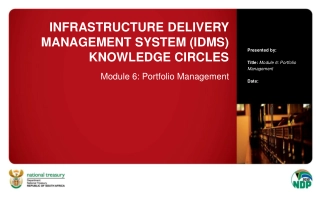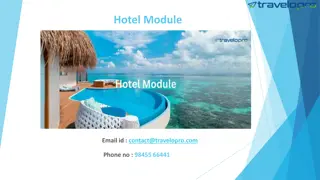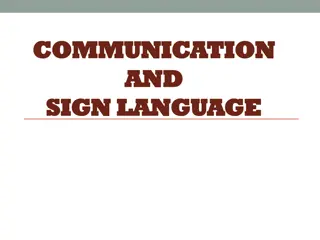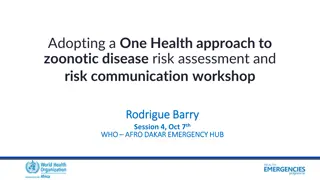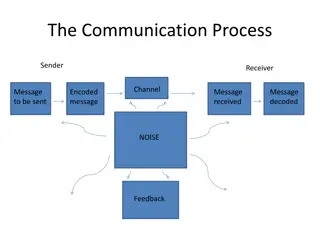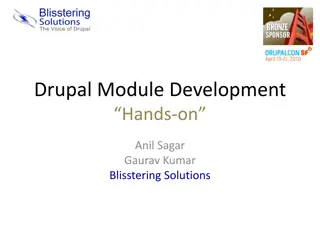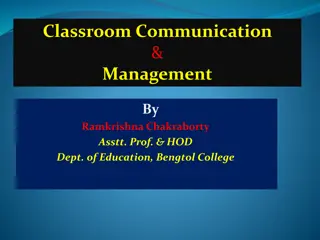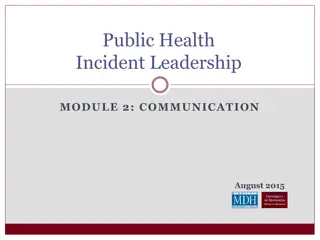
Effective Communication and Campaigning Strategies for Civil Society Organizations
Learn the importance of communication and campaigning for NGOs and activists in raising public awareness. Explore communication strategies, campaign principles, and challenges in migrant and civil society organizations. Find useful resources for overcoming language barriers and stereotypes.
Download Presentation

Please find below an Image/Link to download the presentation.
The content on the website is provided AS IS for your information and personal use only. It may not be sold, licensed, or shared on other websites without obtaining consent from the author. If you encounter any issues during the download, it is possible that the publisher has removed the file from their server.
You are allowed to download the files provided on this website for personal or commercial use, subject to the condition that they are used lawfully. All files are the property of their respective owners.
The content on the website is provided AS IS for your information and personal use only. It may not be sold, licensed, or shared on other websites without obtaining consent from the author.
E N D
Presentation Transcript
Training Module: Communication andCampaigning Dieses Veranstaltung wurde durch den Asyl-, Migrations- und Integrationsfond (AMIF) der Europ ischen Union mitfinanziert. Der Inhalt gibt ausschlie lich die Meinung der EMV-LII-Projektpartnerschaft wieder und liegt in deren alleiniger Verantwortung. Die Europ ische Kommission bernimmt keine Verantwortung f r die Verwendung der darin enthaltenen Informationen. bernimmt keine Verantwortung f r die Verwendung der darin enthaltenen Informationen. Dieses Veranstaltung wurde durch den Asyl-, Migrations- und Integrationsfond (AMIF) der Europ ischen Union mitfinanziert. Der Inhalt gibt ausschlie lich die Meinung der EMV-LII-Projektpartnerschaft wieder und liegt in deren alleiniger Verantwortung. Die Europ ische Kommission 1
Communication and Campaiging Successful Communication and Effective Campaigning for Civil Society Organisations 2
1. 1. Introduction Introduction and and Agenda Agenda Professional press and public relations work is essential for activists, NGOs and MSOs to raise public awareness of their issues. Agenda: 1. What Is Communication? 2. Developing a Communication Strategy 3. Basic Principles of Campaigning Dieses Veranstaltung wurde durch den Asyl-, Migrations- und Integrationsfond (AMIF) der Europ ischen Union mitfinanziert. Der Inhalt gibt ausschlie lich die Meinung der EMV-LII-Projektpartnerschaft wieder und liegt in deren alleiniger Verantwortung. Die Europ ische Kommission bernimmt keine Verantwortung f r die Verwendung der darin enthaltenen Informationen. 3
The The role of communication in migrant and civil society role of communication in migrant and civil society organisations organisations Definition of communication: Everything is communication: Body language, words, silence. Consciously or unconsciously always serves a purpose and is therefore purposeful. Press and public relations work is a professionalised form of communication that provides targeted information to the public. Source: PR Handbuch f r das Bundesprogramm Demokratie Leben! , https://www.demokratie-leben.de/fileadmin/Demokratie- Leben/Downloads_Dokumente/Publikationen/PR-Handbuch_fuer_das_Bundesprogramm_Demokratie_leben.pdf 5
Challenges Challenges of of Communication Communication Language barriers: Write your texts as barrier-free as possible by largely avoiding foreignwords as much as possible and using short, less convoluted sentences. Stereotypes and prejudices: Always remember the principles of gender, diversity mainstreaming and inclusion. More Information and helpful tools in the German context: Rassismuskritischer Sprachgebrauch: https://www.oegg.de/wp- content/uploads/2019/12/Glossar_web.pdf Einfache Sprache: https://www.eleven.ngo/media/pages/media/b753bb5daa-1668372695/handbuch- einfache-sprache.pdf Geschlechtersensible Sprache: https://gb.uni- koeln.de/e2106/e2113/e16894/20210709_Leitfaden_GGSprache_UzK_Webversion_ger.pdf Source: PR Handbuch f r das Bundesprogramm Demokratie Leben! , https://www.demokratie-leben.de/fileadmin/Demokratie- Leben/Downloads_Dokumente/Publikationen/PR-Handbuch_fuer_das_Bundesprogramm_Demokratie_leben.pdf 6
Basic Basic Principles Principles of of Effective EffectiveCommunication Communication Clarity and Comprehensibility Target Group Orientation Authenticity and Credibility 7
Communication Communication Channels Channels Social media (Facebook, Instagram, Twitter) Email and newsletter Events Traditional media (newspapers, radio, TV) 8
2. Developing a Communication Strategy 9
Developing Developing a Communication a Communication Strategy Strategy 3. Define key messages and core topics. 2. Address specific target groups. 1. Define goals and messages. 10
Target Group Analysis Target Group Analysis Who are the target groups? (Political decision-makers, media, migrant communities, general public) Analysing the needs and interests of the target groups Segmentation of communication by target group 11
Development of a Development of a Key Message Key Message 1. Define your goal: What do you want to achieve? Should the message inform, inspire or mobilise? 2. Analyse the target group: Who do you want to address? Think about the needs, interests and values of this group. 3. Formulate the core idea: Think about what the most important point you want to get across is - be as specific as possible. 4. Create an emotional connection: A strong message evokes emotion. Think about what moves the target group and which stories or images support these feelings. 5. Test and adapt: Test the message in the target group, e.g. through interviews or small surveys, and adapt it if necessary. 12
3. Basic Principles of Campaigning 13
Creating Engaging Campaigns 1. System Mapping 2. Audience Understanding 4. Supporter Journey 3. Storytelling 14
1. System Mapping 1. System Mapping Campaign Purpose and Vision: Campaigns start to address urgent issues or create a better future, with a clear vision acting as a guiding destination. Strategy as Roadmap: Strategy is the adaptable path to achieving the vision, offering a structured yet flexible approach to handle unexpected challenges. Problem Analysis and Systems Mapping: Effective campaigns require understanding the root causes, key decision-makers, and societal groups with influence. Systems mapping helps identify connections and leverage points for impactful change. Theory of Change: This framework outlines the steps by which change is expected to occur, based on the motivations and power dynamics of engaged people. Continuous Evaluation: A Theory of Change must be flexible, allowing for ongoing assessment, adjustments, and learning to ensure campaign success and adaptability. Source: https://www.greenpeace.org/static/planet4-storytelling-stateless/2021/05/d4c33feb-creating-engaging-campaigns_digital.pdf 15
2. 2. Audience AudienceUnderstanding Understanding People-Centered Mission: People power" at the core of driving meaningful change. Collaborative Approach: Aim to empower and amplify the actions of all who work for positive transformation. Redefining Success: Success is measured not by the number of followers, but by inspiring courageous actions that further the mission. Balance of Listening and Influence: Importance of both listening to communities and actively promoting mindset shifts needed for societal change. Campaign Planning: Effective campaigns involve understanding the audience, creating a Theory of Change, and using tools to keep people at the heart of planning and action. Source: https://www.greenpeace.org/static/planet4-storytelling-stateless/2021/05/d4c33feb-creating-engaging-campaigns_digital.pdf 16
3. 3. Storytelling Storytelling as as Communication Communication Method Method Definition: Storytelling is a method in which recipients are given knowledge, ideas, products or other information through constructed or real stories. The story as a form of expression should enable the information conveyed to be presented as simply as possible and thus be well received and anchored in the memory in the long term. Source: https://www.textbroker.de/storytelling 17
3. 3. Storytelling Storytelling as as Communication Communication Method Method Storytelling creates a personal connection with the audience by using emotional and logical appeals. Stories about the people the mission supports create a human connection that stands out from purely statistical information and encourages engagement. This connection attracts supporters who want to identify not just with a brand, but with an emotionally tangible mission. Source: https://nonprofithub.org/wp-content/uploads/2023/01/Story-Telling-Guide-2022-1- 1.pdf?vgo_ee=%2BjbE5G2K9YWogoTZUBNNM%2Bcr0vBNPIvWHH%2Fxxd9i1TywQMOwKZSO2Q%3D%3D%3ABngqtafY4jv1pLzIPeQtTs4F6s9eNcv%2B 18
4. 4. Supporter Supporter Journey Journey Purpose of Supporter Journeys: A well-designed supporter journey keeps momentum in campaigns by guiding supporters with relevant actions and messages, fostering deeper engagement and sustained pressure. Flexible Structure: Supporter journeys can follow an overall campaign timeline or break into mini-journeys for specific phases or audience segments, allowing flexibility as the campaign evolves. Long-Term Engagement: Supporter journeys can be viewed as part of a larger, lifelong supporter experience with the organization, linking short-term actions to long-term goals. Balancing Planning and Spontaneity: While pre-planning is essential, adapting to real-time opportunities is equally important to maximize campaign impact. Audience Understanding: Knowing the audience well helps create journeys that feel intuitive and inspiring, keeping supporters actively involved and committed. Source: https://www.greenpeace.org/static/planet4-storytelling-stateless/2021/05/d4c33feb-creating-engaging-campaigns_digital.pdf 19
The The Role Role of of Campaigning Campaigning Create change through: Mobilisation Raising Awareness Influence 20
Example Example: Share : Share the World Food Programme (WFP) World Food Programme (WFP) the Meal Meal Initiative Initiative by by the the United United Nations Nations Innovative Mobile App: The WFP developed a simple mobile app that allows people to donate meals to those in need with just a few taps, making giving accessible and immediate. Clear and Tangible Goal: The campaign set specific, achievable goals, such as feeding children in certain regions, making the impact of each donation clear and personal. Wide Reach through Social Media: WFP promoted the app through social media and partnerships, reaching millions globally and encouraging widespread participation. Gamification and User Engagement: The app incorporated features like progress tracking and achievement badges, increasing user engagement and creating a sense of community. Significant Impact: Since its launch, Share the Meal has provided millions of meals to vulnerable communities, showcasing the power of technology-driven, crowd-sourced solutions in tackling global issues. Ern hre Menschen in Not | ShareTheMeal | Gemeinn tzige Spenden 21
Cooperation Cooperation and and partnerships partnerships for for Successful Successful Campaigns Campaigns Power of Collaboration: Partnering with allies brings diverse perspectives, skills, and networks, strengthening the movement and enabling a more effective approach to addressing complex societal issues. Building Strong Foundations: Clear roles, responsibilities, and trust-based relationships create a cooperative base that extends beyond individual projects, exemplifying shared values. Transparency and Trust: Openness with allies, including shared meetings, skill exchanges, and transparent communication, builds trust and supports lasting coalitions. Mutual Support and Acknowledgment: Contributions vary from resources to expertise, and allies unique roles are acknowledged and credited. Source: https://mobilisationlab.org/resources/21st-century-advocacy-playbook/ 22


